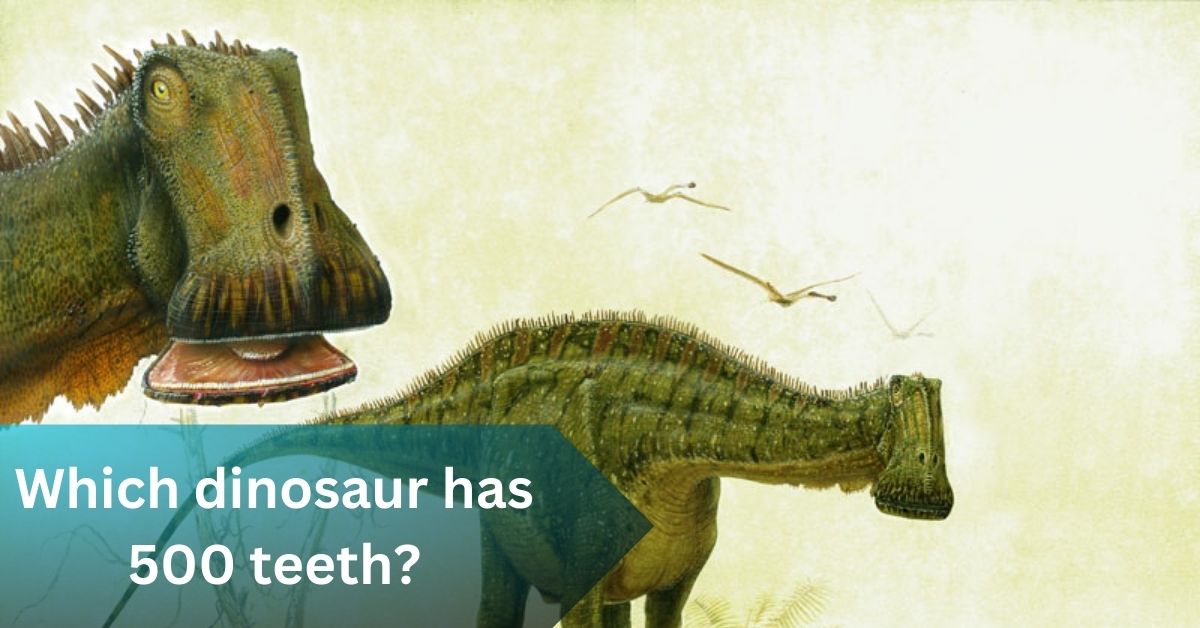Nigersaurus, a herbivorous dinosaur from the Cretaceous period, is known for its unique dental arrangement with up to 500 teeth.
An unconventional herbivore, Nigersaurus roamed the Sahara 110 million years ago. With a wide snout exceeding the skull’s rear, these sauropods grazed using a large mouth for gathering food.
If you want to know about dinosaurs let’s start your informational journey!
List of the ten dinosaurs with the highest number of teeth – Briefly Discuss with us!
Dinosaurs, colossal and formidable beings, inhabited the Earth for millions of years before succumbing to a mass extinction event approximately 65 million years ago. As the predominant species, they shaped the planet, leaving enduring traces evident today through fossils and footprints.
In the Jurassic era, dinosaurs thrived, armed with adaptations such as impressive size for competition in the struggle for resources and sharp teeth for hunting and self-defense. Remarkably, some dinosaurs boasted an astonishing count of up to 500 teeth.
Explore our list below to discover which dinosaurs held the record for the highest number of teeth!
NIGERSAURUS:
Nigersaurus is a dinosaur species that dwelled on Earth during the Cretaceous period, spanning approximately 115 to 105 million years ago. Discovered in the Ténéré Desert of the Republic of Niger in West Africa, the fossils of Nigersaurus have provided paleontologists with crucial insights into the diverse prehistoric fauna of the region.
Physically, Nigersaurus belonged to the sauropod group, characterized by their distinctive long necks and tails. However, what sets Nigersaurus apart is its unique cranial morphology. The dinosaur possessed a broad and comparatively short skull, a feature not commonly associated with sauropods.
This adaptation suggests specialized feeding habits. Nigersaurus was a herbivorous dinosaur, but its feeding strategy differed significantly from other sauropods. Equipped with a wide, flattened muzzle and an intriguing dental arrangement, Nigersaurus was adept at browsing low-lying vegetation.
The jaws of this dinosaur were lined with an extraordinary number of small, peg-like teeth—up to 500 in total. These teeth were closely packed and arranged in multiple rows, facilitating efficient cropping of plants near the ground. Notably, the continuous replacement of teeth throughout its life allowed Nigersaurus to maintain a functional chewing surface.
HADROSAUR:
Hadrosaurs, a diverse group of herbivorous dinosaurs, thrived during the Late Cretaceous period, approximately 80 to 65 million years ago. The name “Hadrosaur” originates from the Greek words “Hadros,” meaning bulky or large, and “Sauros,” meaning lizard.
These dinosaurs were commonly referred to as “duck-billed” due to their distinctive, flattened, and broad snouts, resembling the bill of a duck. Physically, hadrosaurs exhibited a variety of sizes, ranging from small, agile species to massive, imposing forms.
Their most notable feature was the complex dental structure, characterized by numerous teeth adapted for efficient grinding of plant material. This adaptation facilitated their herbivorous diet, enabling them to consume a wide array of vegetation during their existence.
APATOSAURUS:
Apatosaurus, a colossal herbivorous dinosaur, inhabited Earth during the Late Jurassic period, around 154 to 150 million years ago. Originally known as Brontosaurus, this iconic sauropod was later reclassified as Apatosaurus.
Renowned for its immense size, it was one of the largest land animals to ever roam the planet. Apatosaurus boasted a long neck and tail, characteristic of sauropods, with a relatively small head.
Its distinctive feature was the presence of elongated neural spines along its vertebrae, forming a continuous sail-like structure. The function of this sail remains a subject of scientific inquiry, with hypotheses ranging from thermoregulation to display during courtship.
MAPUSAURUS:
Mapusaurus is a theropod dinosaur that existed during the Late Cretaceous period, approximately 100 million years ago. Belonging to the carcharodontosaurid family, it was a large and carnivorous dinosaur that roamed the ancient landscapes of what is now South America.
The fossils of Mapusaurus have been discovered in Argentina, providing paleontologists with valuable insights into the prehistoric fauna of the region. In terms of size, Mapusaurus was formidable, with estimates suggesting lengths of up to 30 feet (9 meters) or more.
Its skeletal structure indicates characteristics typical of theropods, featuring a bipedal stance with powerful hind limbs and sharp, serrated teeth well-suited for hunting and consuming prey.
ALLOSAURUS:
Allosaurus, a significant predator of the Late Jurassic period, existed around 155 to 150 million years ago. Its fossilized remains have been discovered in North America, Europe, and Africa, showcasing its widespread distribution.
This bipedal dinosaur boasted a robust physique, reaching lengths exceeding 30 feet. With a large skull and sharp, serrated teeth, Allosaurus was well-equipped for carnivorous activities. Its relatively short arms featured three-fingered hands with sharp claws, while strong hind limbs facilitated efficient bipedal movement.
As a top predator, Allosaurus likely played a pivotal role in its ecosystem. Fossil evidence suggests a diet of herbivorous dinosaurs, possibly engaged in pack hunting for larger prey. The structure of its jaws and teeth indicated effective slashing and biting mechanisms during feeding.
GIGANOTOSAURUS:
Giganotosaurus was a giant theropod dinosaur that lived in South America during the Late Cretaceous period, around 98 million years ago. It was one of the largest meat-eating dinosaurs, reaching lengths of up to 40 feet or more.
With sharp teeth and a powerful build, Giganotosaurus was likely a top predator in its ecosystem, preying on large herbivorous dinosaurs. Its fossils have been found in Argentina, contributing to our understanding of dinosaur diversity and paleoecology in South America during the Late Cretaceous.
CARCHARODONTOSAURUS:
Carcharodontosaurus, a formidable theropod dinosaur, thrived during the Late Cretaceous period, approximately 100 to 94 million years ago. Its name, meaning “shark-toothed lizard,” aptly describes its most distinctive feature—impressive serrated teeth reminiscent of a shark’s.
This dinosaur was a colossal creature, with estimates suggesting lengths of up to 40 feet or more. Its robust build, powerful hind limbs, and relatively short arms equipped with three-fingered hands made it a formidable predator. The defining characteristic, however, was its large skull housing rows of sharp, serrated teeth, indicating a carnivorous diet.
Carcharodontosaurus fossils have been discovered in North Africa, particularly in regions that were once part of the supercontinent Gondwana. Countries like Morocco and Algeria have yielded crucial findings, contributing significantly to our understanding of the dinosaur fauna in this part of the world.
ANKYLOSAURUS:
Ankylosaurus, a herbivorous dinosaur, lived during the Late Cretaceous period, around 68 to 66 million years ago. Recognized for its distinct armored appearance, Ankylosaurus was a member of the dinosaur group known as ankylosaurids.
Physically, Ankylosaurus was characterized by a heavily armored body, featuring thick, bony plates embedded in its skin called osteoderms. These plates acted as protective armor, shielding the dinosaur from potential predators.
The most iconic feature was a large, club-like tail that was used both for defense and potentially for intraspecific combat. The skull of Ankylosaurus was low-slung and wide, with a beak-like snout adapted for grazing on vegetation.
Its teeth were small and leaf-shaped, suitable for cropping and processing plant material. Despite its formidable appearance, Ankylosaurus was a herbivore, likely feeding on low-lying vegetation.
TYRANNOSAURUS REX:
Tyrannosaurus rex, often abbreviated as T. rex, was one of the largest and most iconic carnivorous dinosaurs that lived during the Late Cretaceous period, around 68 to 66 million years ago. Recognized for its immense size, powerful jaws, and tiny forelimbs, Undoubtedly, the most well-known dinosaur species is the Tyrannosaurus Rex.
The name “Tyrannosaurus rex” translates to “tyrant lizard king,” reflecting its status as a dominant predator of its time. It had a robust, bipedal stance with powerful hind limbs, allowing for rapid movement. Despite its massive size, T. rex is believed to have been a surprisingly agile and fast hunter.
T. rex had a large skull with powerful jaws lined with serrated teeth, capable of crushing bone. Its teeth were adapted for tearing and consuming flesh, indicating a carnivorous diet. The short, two-fingered forelimbs, though seemingly small for its size, were muscular and likely served a role in grasping and manipulating prey.
VELOCIRAPTOR:
Velociraptor, a small but formidable theropod dinosaur, inhabited Earth during the Late Cretaceous period, around 85 to 75 million years ago. Recognized for its appearance in popular culture, especially in the Jurassic Park film series, Velociraptor was a member of the dromaeosaurid family.
With an estimated length of around 6.6 feet (2 meters) and a weight of about 33 pounds (15 kilograms), Velociraptor was a relatively small dinosaur. It featured a lightweight, agile build with a long, stiff tail that likely served for balance during rapid movements. Velociraptor walked on two legs, showcasing its bipedal nature.
The most distinctive feature of Velociraptors was the large, sickle-shaped retractable claw on each hind foot. This specialized toe claw, combined with its sharp teeth, was a formidable adaptation for hunting and capturing prey. Velociraptor was likely an active predator, preying on smaller dinosaurs and possibly even early mammals.
Frequently Asked Questions:
Why did Nigersaurus have so many teeth?
Nigersaurus had a unique dental arrangement with numerous small, closely packed teeth in its jaws, likely adapted for efficiently cropping low-lying vegetation.
What type of dinosaur is Nigersaurus?
Nigersaurus is a sauropod dinosaur, belonging to the group of long-necked, herbivorous dinosaurs.
When did Nigersaurus live?
Nigersaurus lived during the Cretaceous period, around 115 to 105 million years ago.
Where were Nigersaurus fossils discovered?
The fossils of Nigersaurus were unearthed in the Republic of Niger in West Africa.
Conclusion:
At the end of the conclusion;
Nigersaurus, a plant-eating dinosaur from the Cretaceous era, is renowned for its distinctively arranged teeth, numbering up to 500.
I hope you will all understand the concept of dinosaurs.
Also Read:


